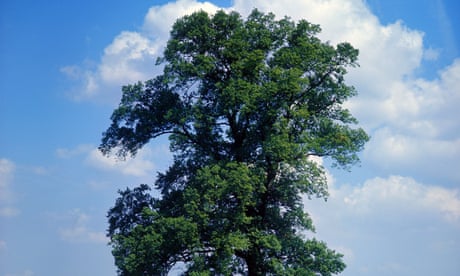
Constable painted them. Shakespeare wrote of them. And Francis Drake sailed the world in a ship made from them. English elms were a mainstay of England’s landscape and culture – until they all but disappeared to Dutch elm disease in the 1970s.
Since that devastation, when 25m elms were felled, enthusiasts and academics have searched for varieties resistant to the fungus spread by Scolytus beetles that kills the trees.
Results have been mixed. Scientists in Europe and the US have created hybrids but they are not always suited to the British climate, and – a crucial factor for some elm devotees – they lack the form of the classic English elm: a figure-of-eight shape with branches spreading at the bottom and top of the trunk with a cinched waist in the middle.
Now there is growing excitement about a new disease-resistant variety that appears to have many of the characteristics of English elms, whose modern fans include King Charles, who said in 2017 that he had “planted an avenue of [an American variety] at Highgrove then watched, miserably, as many of them succumbed”.
The new variety was created by Dr David Herling and Fergus Poncia, friends who were horrified to watch elms being chainsawed as schoolboys.
“At the time, they said it wouldn’t be an issue because when you chop down an elm, it sends up saplings from its roots,” Poncia said. “The problem is that as soon as they reach 20ft, they become attractive to insects and become reinfected.
“David’s theory was to take a proven field resistant elm and cross it with an English elm that had the classic shape but was a survivor. We found a stand of elms at Tonge Mill near Faversham.”
The English elms that so often featured in Constable paintings, such as The Hay Wain, were probably introduced to Britain by the Romans, who wanted a fast-growing tree to make bridges. They are known as Atinian elms, a variety of field elms, and distinct from wych elms that have been native to Britain since the bronze age and thrive in Scotland and northern England.
Elms of all kinds may be vulnerable to the Scolytus beetle, but their wood is resistant to the gribble worms that live in water, so are ideal for bridge foundations in marshland and for the keels of ships, such as the Golden Hinde.
Herling, who ran the graduate diploma in law at City University, training barristers, had befriended some Italian academics who had developed a disease-resistant elm and, in 2014, they gave him some stock. He and Poncia had taken some saplings and waited until they flowered. “When it flowers, you only have a window of a few hours, so you have to sit up overnight, watching, and hope the others will flower at the same time. Then you take the pollen off with a paintbrush from one and paste it on to the other. It’s not like putting two bunny rabbits in a hutch and waiting.”
They ended up with 130 saplings, and Poncia, who was working as a lawyer for Southern Water, found some land to plant them at Wateringbury sewage treatment works in Kent. “A waste water treatment plant is ideal because deer can’t get in through the wire fencing,” Poncia said. “Otherwise they will eat any saplings as they grow out of their protective tubes.”
By 2018, the saplings were strong enough for the big test. The two men clambered up to inoculate the trees with the latest variety of Dutch elm disease. They were left with four that were both disease-free and seemed to have the upright shape and branch angle of an English elm, Poncia said. It was a moment of triumph, but with a cruel twist. Herling had to deal with a different disease, cancer, and died in March 2020. “David was, in many ways, not of his time – more suited to the Renaissance or the 18th century,” his wife Joanna said. “I think he felt the elms in some ways ‘kept watch’ and represented something which should not have changed.
“Always, he was looking for the form which matched the ‘folk’ memory of the majestic elms of the English landscape
“I feel that the DNA of our children is woven into the DNA of his elm researches and creations. I remember seeing him as, like Mendel with a tiny paintbrush, he moved pollen in the conservatory between seedlings.”
Since Herling’s death, the work has continued. The four candidates were multiplied by researchers at the leading horticultural centre NIAB EMR in East Malling, Kent, and others have been given to growers including the National Elm Collection in Brighton, the Lees Court Estate in Faversham and Gravetye Manor in East Grinstead.
Prof Richard Buggs, senior research leader at Kew, said that Herling and Poncia’s elms were “promising”. “[Herling’s] seem to have been particularly successful, and it’s very sad that he died just as it was coming to fruition,” he said. “We’ve been sequencing the genomes of the progeny from his cross because it gives us the opportunity to try and narrow down which bits of the genome actually confer resistance.”
The ultimate aim for Poncia is to give away seedlings and saplings to repopulate the landscape. “People will only plant them if they cost a few pence, rather than trees from nurseries for £30 each,” he said. “We just want to repair the environment to what it was historically.”